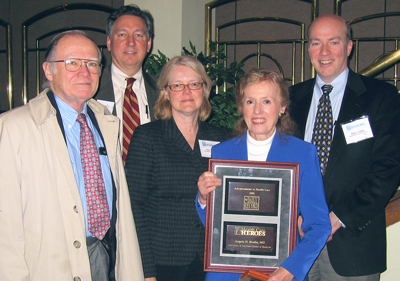 Scientific research builds upon itself. It often spans decades and revolutionizes initial discoveries to create more powerful outcomes. One dead end can lead to something bigger, making scientific development a cumulative triumph. Such is the story of aromatase inhibitors.
Scientific research builds upon itself. It often spans decades and revolutionizes initial discoveries to create more powerful outcomes. One dead end can lead to something bigger, making scientific development a cumulative triumph. Such is the story of aromatase inhibitors.
“It’s interesting how science works,” said Harry Brodie, PhD. “We got to a treatment for breast cancer because of a request for proposals that had to do with reproduction. It could have ended in a failed project that no one would remember; instead it ended up in something more important. We just followed the science.”
The research behind aromatase inhibitors began at the Worcester Foundation for Experimental Biology Institute in Shrewsbury, MA, under Harry and came to fruition under his wife, Angela Hartley Brodie, PhD, at the University of Maryland School of Medicine (UMSOM) and the University of Maryland Greenebaum Comprehensive Cancer Center (UMGCCC). Her work developing aromatase inhibitors was a paradigm shift on how to reduce the level of estrogen in the body and thereby block the growth of cancer cells. Aromatase is an enzyme that plays a key role in the biosynthesis of estrogen, which fuels the growth of cancer cells.
Harry wanted to honor Angela’s life and their dedication and commitment as scientists. He understands firsthand the importance of philanthropy. “We were always looking for how we could get grants and contracts because that’s how we existed.” He made a transformative estate gift of $1 million to the Building for Life Campaign to help fund the new home of UMGCCC, the Roslyn and Leonard Stoler Center for Advanced Medicine, and to increase the Department of Pharmacology endowed professorship established by the Greenebaum Family Foundation to honor Angela and Harry’s work.
“I am fortunate to be able to do this,” Harry said. “It’s where Angela worked for so long and the field where she made her biggest contribution.”
At the investiture of Stuart S. Martin, PhD, professor of pharmacology and physiology at UMSOM, as the inaugural Drs. Angela and Harry Brodie Professor of Translational Cancer Research, Michael Greenebaum said that his late mother, Marlene, was treated with an aromatase inhibitor after her breast cancer recurred. “The development of the aromatase inhibitor by the Brodies really is what kept my mom alive for many years.”
Angela’s distinguished career at UMSOM and UMGCCC spanned 37 years until her retirement in 2016. She was a professor of pharmacology at the school and a researcher in the Hormone Responsive Cancers Program at the center. Illness forced her into retirement in 2016; and on June 7, 2017, at 82, she died from pancreatic cancer and complications due to Parkinson’s Disease.
Harry started at the Worcester Foundation with a postdoctoral fellowship funded by the National Institute of Child Health and Human Development. “The Worcester Foundation was well known by the time I arrived because they had just a year or two earlier gotten approval for the first contraceptive pill,” he said.
Harry studied steroid metabolism and the transformation of male and female hormones. With an NIH contract to develop a new contraceptive, his team had limited success blocking reproduction in mammals such as rats. “We were successful in the sense that—if we did inject the inhibitor—we would see fewer pups in the fallopian tubes than if we didn’t,” he explained. “We could never get to 100 percent.”
At that time, breast cancer research came to the forefront, and he rerouted his research. “The principle was the same,” Harry said. “It was pretty well accepted that estrogen played a role in blocking the cancer. If you inhibited estrogen, you couldn’t stop it completely, but you could reduce the development. These compounds reduced estrogen and interfered with conception so they might inhibit cancer growth.”
By then he and Angela had met and married in 1964. Following a hiatus that spanned the birth of their sons, John and Mark, “she joined my group in 1971 and we became research partners,” Harry said. They developed several steroidal aromatase inhibitors. However, their project stalled because their findings were limited to lab animals. “We were trying to get drug companies interested in it, but it wasn’t happening,” he said. “It was a bit discouraging.” With a young family to support and the tenuous nature of research support, Harry made the decision to join NIH and the family moved to Maryland in 1979. “I like to say I became a grant giver, rather than a grant getter,” he explained.
Angela kept pushing the science forward at UMSOM and UMGCCC. In 1982, her collaboration with British oncologist, Charles Coombes, lead to successful clinical trials funded by Novartis and the eventual market of the first aromatase inhibitor drug, Formestane, in 1994. The drug has helped thousands of women conquer breast cancer. During her tenure, Angela received her first of many major awards: the Brinker Award for Scientific Distinction from the Susan G. Komen Breast Cancer Foundation.